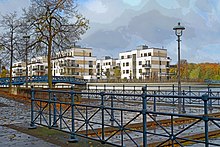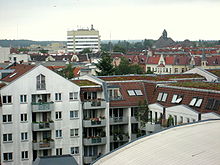Berlin Tegel
|
Tegel district of Berlin |
|
|---|---|
| Coordinates | 52 ° 35 ′ 0 ″ N , 13 ° 17 ′ 0 ″ E |
| surface | 33.7 km² |
| Residents | 36,986 (Dec. 31, 2019) |
| Population density | 1098 inhabitants / km² |
| Incorporation | Oct. 1, 1920 |
| Postcodes | 13405, 13503, 13505, 13507, 13509 |
| District number | 1202 |
| structure | |
| Administrative district | Reinickendorf |
| Locations | |
Tegel is a locality in the Berlin district of Reinickendorf . The district is known nationwide primarily as the location of Berlin-Tegel Airport and the Tegel correctional facility . In terms of area, Tegel is the second largest district in Berlin after Köpenick .
Significant buildings
The district is a popular destination in the north of Berlin due to the Tegeler See and the Greenwich promenade located there (named after Reinickendorf's partner district in London: Greenwich ). Ships begin their cruises through Berlin's waters on the Greenwich promenade below the Tegeler Hafenbrücke (Sechserbrücke) . In addition, Tegel Castle (Humboldt Castle) with the associated castle park and the former Borsigwerke are located in Tegel , some of which now house the Hallen Am Borsigturm shopping center . On the occasion of the international building exhibitions in 1984 and 1987, the new Tegeler Hafen with the Humboldt library and interesting housing projects by various international architects was created at the former Tegel industrial port opposite the watermill . The " fat Marie " is said to be the oldest tree in Berlin and around 900 years old.
On the west bank of the Tegeler See, on the Reiherwerder peninsula , there is also the guest house of the Foreign Office in the Villa Borsig , as well as the Foreign Service Academy, which is used to train German and foreign diplomats.
The Alt-Tegel village church stands on the original village green , which lies directly above the promenade of Lake Tegel . The Catholic St. Bernhard Church , located in Tegel-Süd on Bernauer Strasse , was built according to plans by Alfons Leitl and completed in 1960. The only civil Russian Orthodox Russian cemetery with the St. Konstantin and Helena Church is located at Wittestrasse 37 .
In Tegel, the Alte Waldschänke is the oldest restaurant in Berlin (within its borders from 1920).
Lakes and islands in the district

Lakes
Islands and peninsulas
- Hasselwerder
- Humboldt Island
- Valentine's Day
- Scharfenberg
- Lindwerder
- Maienwerder
- Reiherwerder (peninsula)
- Reiswerder
- Baumwerder
- Gänsewerder
history
Tegel was created as a square-like cul-de-sac that ends at Lake Tegel. This location would suggest that Tegel was an originally Slavic fishing village. However, no traces of late Slavic settlement have yet been found. Since four parish hooves were found for Tegel at an early stage , the conclusion that Tegel was founded soon after the end of the Brandenburg tithe dispute in 1237, because the margrave had undertaken to provide all villages with four tax-free hooves in favor of the local church and its pastor. Tegel was first mentioned in 1322 as the church village of Tygel . Apparently Tegel must have had a remarkable brick building. Another explanation sees a Slavic root word in the place name Tegel , which means "appendage". This would refer to the Tegeler See , which is an offshoot of the Havel .
In 1361 a (water) mill (molendium) is mentioned in Tegel. The land book of Charles IV (1375) shows 32 hooves for Tegel, four of which are parish hooves. There are six cottages in the village . Next to the mentioned mill there is also a jug (taberna) . Since 1361 the whole village has belonged to the nuns of Spandau , who bought it from Johann Wolf, a citizen of Cölln , without prejudice to the Margrave's tax rights. From 1558 to 1872 the village belonged to the Spandau office. A Schulzengut with four free hooves can be proven in Tegel by 1590 at the latest . Then in 1737 the Tegel Castle was built .

" Tegel , Kirchdorf, 1½ m. Northwest of Berlin, on the Tegelschen See, in Niederbarnimschen Kreis, 25 houses and 164 inhabitants. The von Humboldt family has a castle worth seeing near Tegel , with a large, wonderful park."
Tegel has had a train station since 1893, today 's Tegel S-Bahn station on the Kremmener Bahn . In the time of West Berlin , when the Reinickendorf district belonged to the French sector, the so-called Franzosenbahnhof was set up southwest of the S-Bahn station. It was the destination or starting point of all French troop transports by rail.
Gustav Lilienthal founded the non-profit housing cooperative Freie Scholle at Tegeler Fließ in 1895 .
In 1920, the northernmost district of Berlin, later named after "Alt-Reinickendorf", was initially given the name of the then largest village in north Berlin, "Tegel District". However, the decision was made in favor of "District Reinickendorf".
At the turn of the 20th century, Tegel experienced an enormous upswing as a recreational area of the city of Berlin - among other things, boat trips took place from here, for which the port was created or expanded and the Tegel harbor bridge was built.
Between 1930 and 1934 the Association for Space Travel carried out various tests with liquid rockets on the area of the former Tegel firing range . Despite numerous explosions, it climbs up to three kilometers. Numerous well-known German rocket researchers, such as Wernher von Braun , were members of the association.
Tegel was the location of the Tegel transmitter from 1933 to 1948 . A wire suspended in a 165 meter high wooden tower was used as the antenna. The tower, which was dismantled to a height of 86 meters for structural reasons in 1940, was blown up on December 16, 1948 during the construction of Tegel Airport.
The extension of today's underground line U6 from the Seestraße depot to Tegel (today: Alt-Tegel underground station ) was the first new construction project of the Berlin underground network after the Second World War in the 1950s . The inauguration of the route , which was partly run as an embankment , took place at the beginning of June 1958 in the presence of the Governing Mayor Willy Brandt . At the same time, the tram lines running through the district from 1881 were discontinued, including the lines to Heiligensee and Tegelort that were opened in 1913 . The tram station on Schloßstraße was also closed.

On the site of the former Tegel gasworks, apartment buildings were built in three construction phases (around 1960, around 1970 and around 1990). Several high-rise buildings were built near the former gasworks port, giving residents on the upper floors an unobstructed view of the lake, the forest and the town of Tegel. Together with the "Waldidyll" settlement, these houses form the Tegel-Süd location.
Gravel was mined north of the airport until 1978 . This created the airport lake , the largest part of which forms a bird reserve together with the adjacent forest. At the northernmost point of the lake there is a swimming area.
As part of the International Building Exhibition from 1984 to 1988, imposing rows of living quarters and queues with a total of 350 apartments were built at Tegeler Hafen, around the Greenwich Promenade, and a terminal for river cruises has also been created in the meantime . In 2009, construction work began on the island of Tegel. The Russian investor, who had acquired the island from a Berlin project development company, had to file for bankruptcy as part of the financial crisis .
In 1999 the Hallen Am Borsigturm shopping center was opened, built by Herlitz Falkenhöh AG . The new building includes old, listed buildings belonging to the Borsigwerke .
Climate table
| Berlin Tegel | ||||||||||||||||||||||||||||||||||||||||||||||||
|---|---|---|---|---|---|---|---|---|---|---|---|---|---|---|---|---|---|---|---|---|---|---|---|---|---|---|---|---|---|---|---|---|---|---|---|---|---|---|---|---|---|---|---|---|---|---|---|---|
| Climate diagram | ||||||||||||||||||||||||||||||||||||||||||||||||
| ||||||||||||||||||||||||||||||||||||||||||||||||
|
Average monthly temperatures and precipitation for Berlin-Tegel
Source: wetterkontor.de
|
|||||||||||||||||||||||||||||||||||||||||||||||||||||||||||||||||||||||||||||||||||||||||||||||||||||||||||||||||||||||||||||||||||||||||||||||||||||||||||||||||||||
See also
- List of streets and squares in Berlin-Tegel
- List of cultural monuments in Berlin-Tegel
- List of stumbling blocks in Berlin-Tegel
literature
- Meinhard Schröder: Tegel. Between idyll and metropolis , be.bra verlag, Berlin 2015, ISBN 978-3-8148-0213-8 .
- August Wietholz: History of the village and Tegel Castle. Knüppel, Berlin 1998, ISBN 3-927611-07-7 (facsimile of the 1922 edition).
Web links
Individual evidence
- ^ JGA Ludwig Helling (ed.): History-statistical-topographical pocket book of Berlin and its immediate surroundings . HAW Logier, Berlin 1830. Online at google.com/books, accessed May 24, 2013






